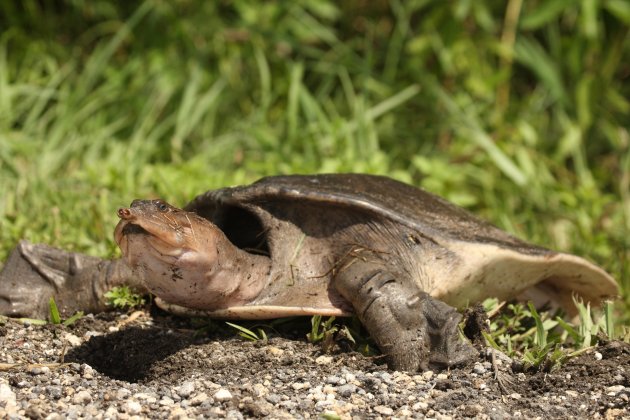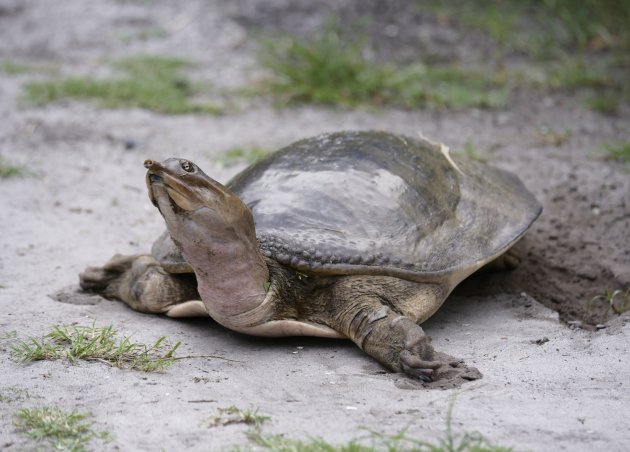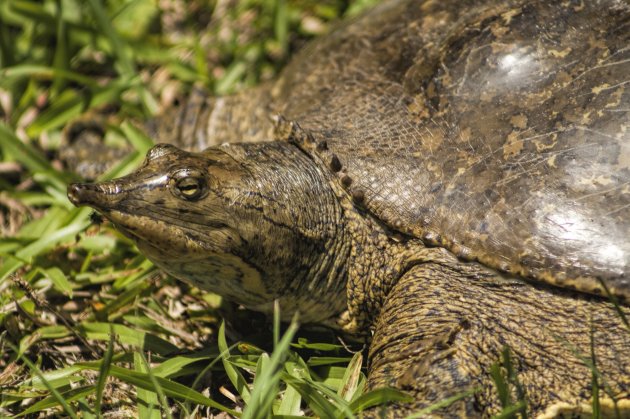Softshell turtles may be one of the most unique of all the “Testudines.” This strange-looking aquatic critter can make a good pet for the experienced reptile/turtle-keeper.
There are 25 species of softshell turtles residing from the Far East to Africa to New Guinea to North America. In some cultures, they are considered a delicacy and are farm-raised for their meat and other properties. And although they do differ in appearance (somewhat) throughout their native habitats, these turtles all have one thing in common, they lack a hard carapace.
Before you enlist the help of the internet to track down a softshell turtle, let's discover the ins-and-outs of keeping the common North American Softshell Turtle as a pet.

The Appearance of the North American Softshell Turtle
There are three species of softshell turtle (from North America) that are commonly kept as pets; the Spiny, the Smooth, and the Florida softshell turtle.
The Spiny Softshell Turtle
This turtle has a long snout and a leathery olive-grey, brownish or tan shell with the edges tinted yellow with a black outline. As the name suggests, the carapace also has small “spikes” running along it. The shell of the males and young turtles also feature large spots, while the female’s spots are smaller. Legs and heads of both sexes are either dark green or grey with distinct patterning. Along the side of their faces runs a yellow stripe outlined in black. Females can reach shell-sizes of 16.9 inches long, males are smaller at 9 inches long.
The Smooth Softshell Turtle
As the name suggests, the Smooth Softshell Turtle’s carapace does not have any bumps, ridges, or spines - they are flat and leathery with flexible edges. Females of this species can reach 14-inches while males are about half that length. Adult males are grey or brown with small dashes and dots on their backs, females are drab and have large dark splotches. The noses of both the sexes tapper to a point.
The Florida Softshell Turtle
This species of turtle has a pancake-like shell covered in leathery skin ranging from olive green to dark brown and a white to cream-colored underside. The neck is very long and its head is elongated with a long snorkel-like snout. The feet are large and webbed with three claws on each. The Florida softshell turtle is also quite large and can reach carapace lengths of up to 29.9 inches and can reach weights of up to 40 pounds.

Can You Keep a Softshell Turtle as a Pet?
Never take a softshell turtle (or any reptile/animal/bird) from its natural habitat. This practice is both harmful to the creature and illegal in some regions. The softshell turtle is no exception, so always purchase your pet from a reputable breeder.
The Personality and Temperament of the Softshell Turtle
The softshell turtle is not only known for its odd appearance, but it can also be an aggressive critter. When agitated, the softshell turtle may use its powerful jaws (designed for crushing mollusks) to give you a sharp nip. It is also a very fast reptile that can move up to 15 mph on both land and in water. The claws on the softshell turtle can also produce a nasty scratch, so handle this pet with the utmost care. Although most captive-bred softshells are relatively docile, their aggressiveness does warrant mentioning. This pet is not recommended for first-time reptile owners or for those homes with small children or other pets that have access to the softshell turtle habitat.
How Do You House a Softshell Turtle?
The species of softshell turtle you choose will determine the size of the aquarium you need. The bigger species (like the Florida) will need a substantial enclosure. Even the smaller softshell turtles will require a 75 to 100-gallon tank.
When setting up your softshell turtle habitat, be sure you do not use anything sharp as this can pierce the turtle, causing injury. For this reason, do not use gravel on the bottom of the tank. This species loves to bury themselves, so clean play sand is highly recommended as a substrate source.
The tank must also be kept very clean, so you will need to enlist the aid of a canister or submersible filter to help reduce bacteria and fungal growth.
Your softshell turtle will also need a basking area. Driftwood or floating islands work well. Place live aquatic plants in your turtle's habitat to make it more natural.
The enclosure of the softshell turtle must be kept between 70 and 80 degrees Fahrenheit. For this, you can use an aquarium heater for the water. Most owners of this pet find a reptile heating lamp kept at 90 degrees F. works well.
Since the softshell turtle cannot metabolize calcium on its own, you will also need a UVB light. This light should be kept on from 10 to 12 hours each day to mimic a natural daytime/nighttime cycle. For optimal effectiveness, do not block this light with any type of plastic or glass and change the bulbs every six to nine months.

Feeding Your Softshell Turtle
In the wild, the softshell turtle eats a variety of food including eggs, fish, insects, and small amphibians.
The captive softshell turtle will primarily need a carnivorous diet consisting of;
- Gut-loaded crickets (those fed nutritiously for reptiles)
- Worms
- Other insects
- Small fish
- Captive-raised softshell turtles may also eat turtle pellets
- Larger adults may eat pinky mice and small frogs
Always feed your softshell turtle in the water, so it does not have to leave its pool to get its food.
Other Softshell Turtle Species Facts
Check out these other species of softshell turtles and their unique traits.
- Cantor’s soft-shelled turtle is from Asia. It can reach a length of six-feet
- The New Guinea soft-shelled can exceed four feet in length.
- India and Pakistan, have two uniquely marked species; the Ganges and the Peacock soft-shell turtle. Both of these have intricate patterns of dots and lines that resemble the face of an owl. They can grow up to two-feet long.
- The Chinese soft-shelled is very common due to its being mass farmed for the food industry. Albinos of this species have a whitish-pink base color, with colors of yellow, peach, and orange running throughout. They can grow from 10 to 13-inches long.
The Softshell Turtle & You
If the softshell turtle sounds like the right pet for you, do your research to find a reputable breeder or rescue organization. Know that these reptiles MUST be kept in aquatic habitat and are not for novice turtle-keepers, as they can be aggressive. Having a healthy and happy softshell turtle can be a rewarding experience for the right person.
Further reading and references:
- SREL Herpetology. Spiny Softshell (Apalone spinifera)
- BioKIDS. Smooth Softshelled Turtle
- California Turtle & Tortoise Club. North American Soft-Shell Turtles, Apalone species
- Ben Team (March 7, 2017) - Softshell Turtle Pet Owners Guide. Softshell Turtles care, behavior, diet, interacting, costs and health.